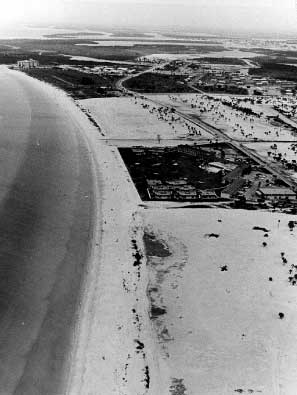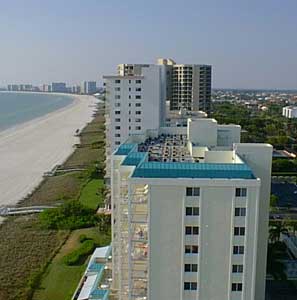The Deltona Years:
A gentle dream shattered
By Marion Nicolay
Special to the Eagle
The five men drove west from U. S. 41, over the old wooden swing bridge, past Goodland and Horr's Island and along S. R. 92 (San Marco Road) to the beach. To the south ran a paved road leading to the U. S. Air Force's missile tracking station, still in readiness although no longer used.
The three Mackle brothers (Elliott, Robert and Frank) owned the Deltona Corp., founded by their father. They had been successful in developing several other communities in Florida, and they were scouting a new location. With Jim Vensel, their city planner, and Neil Bahr, their chief sales agent, they came to a relatively unspoiled Marco Island in 1962 and fell in love.
There wasn't much to see at that time, but in their eyes a tropical resort was already rising from the sand and swamp. They saw the paved road to the tracking station as a possible future site for an airstrip.
At that time, most of the island was owned by Barron Collier's company. This New York advertising magnate had bought more than a million acres in Southwest Florida, established Collier County and helped to complete the Tamiami Trail. He had founded Collier City on Marco Island and had sold lots in the late 1920s, until the Depression closed down the enterprise.
Other businesses had flourished on the island, notably two clam factories which had drawn the railroad for a period of time, with a rail link where the Judge S.S. Jolley Bridge now stands.
Clams had not been Marco's only attraction. The Olde Marco Inn had been in almost continuous operation since the mid-1870s as a hotel and headquarters for game fishing. At Caxambas on the south end of the island, there had once been several homes and a hotel run by the Barfield family, but the Collier Corp. had relocated these people to Goodland in 1949 to make way for a development that never took place. Certainly, there was space in every direction for the Deltona men to dream about.
Before dreams, practical matters intervened. Mosquito control was a pressing problem, a safe and steady water supply had to be in operation, sewage and refuse disposal had to be arranged, financing had to be found.
If all of this could be managed, city planning must begin: areas for commercial and residential development, churches, schools, medical facilities and so on. Roads and bridges must be built. The tropical paradise would not take shape overnight.
Eventually, Deltona purchased most of the land on the island, secured the required state and county permits and also the all-important offshore dredging rights. This would enable them to obtain fill for fingers of land interlaced with canals or waterways, which would in turn provide hundreds of waterfront home sites.
The Army Corps of Engineers became involved because construction might create a hazard to shipping lanes or waterways. Since Deltona had no such plans, the Corps' permit for dredging was issued, but work had to be completed in three years. The original grand plan was expected to take 15 years. Accordingly, the master plan was divided on paper into several phases, so that each could be finished in the required length of time. Thus, as phase 1 was nearing completion, a permit could be requested for phase 2 and so on.
The obstacles were slowly overcome, countless tons of dirt were moved, an entire canal system was devised to create new landfill sites for homes, the mosquitoes were partially vanquished and the island was ready for its first visitors in early 1965. Deltona had sent its chief architect, Herb Savage, to Hawaii to absorb the Polynesian atmosphere they wanted for the island, and Herb had come through with flair and style. Aerial photos were taken regularly and invitations were sent out.
Neil Bahr had to generate sales immediately, to replenish the cash outlay that Deltona had made for the island's development. He set up franchised agents in the Northeast and even in Europe to drum up interest in the tropical paradise that was taking shape in the gulf. The company stood behind the sales force and offered refunds if any client was disappointed in his investment after a personal visit to the island.
The Mackles succeeded beyond their wildest dreams. On Jan. 31, the crowds started arriving: by boat, by plane, by bus, by car they came to see the miracle in the swamp. They lunched at the Olde Marco Inn, the new Yacht Club, the new Marco Beach Hotel (now the Voyager), or they ate picnic lunches on the beach. It was estimated later that 25,000 people attended the grand opening, and many of them became customers.
Thus launched, Deltona proceeded with its plans. Homes went up, roads were paved, churches were built, a school was established and the population grew slowly. Graceful high buildings rose beside the water, and new homes grew like mushrooms.
The Mackle Brothers were developing not only a community, but a reputation for fair dealing. If you didn't like a piece of land you had bought sight unseen , you were entitled to a refund or a trade-up.
One of the chief bright spots in this period was the opening of the Marco Beach Hotel adjoining the Voyager. It was Polynesian in style, an award-winning design by Herb Savage, and it was Frank Mackle's pride and joy. It was called the Jewel of the Gulf.
Things went wrong slowly, sometimes almost imperceptibly. The environmental movement of the '60s started to catch up with wetlands developers, some of it as a reaction to past excesses by other companies. Permits began to lag. In addition to dealing with the Corps of Engineers, Deltona now had to reckon with the Fish and Wildlife Service and the Florida Audubon Society.
At first the society was interested only in the protection of eagles, and then it became concerned for all wild birds.
Deltona obligingly deeded over the three small "A B C" islands near the Jolley Bridge as a protected wildlife sanctuary.
But the Department of the Interior now began to take a keener interest in the Marco operation. One disagreement led to another, and Deltona could see the road narrowing ahead of them. Though compromises were sometimes worked out, the company was doomed. Unable to complete units which depended upon new permits from the Corps, the Mackles could have declared bankruptcy and left prospective customers stranded. Instead, they offered people who had money deposited for homes a chance for a better lot in an existing area, or a complete refund, and this altruistic policy destroyed them in the end.
The money began flowing out faster than it came in. Deltona started selling off island land to other developers, and gave up its master plan for the island and the land bordering the east side of Marco River.
The climax for Frank Mackle came when he had to sell his beloved hotel to the Marriott chain.
Deltona left its mark indelibly on the island, but there is no telling what kind of community it would be today if the Mackles had been allowed to proceed as planned.
Many people became wealthy working with Deltona, but the corporation failed because Frank Mackle was a man of his word and because his dream clashed head on with environmentalism and wetlands protection policies.
People still argue that his master plan would have ruined the local habitat and fragile ecosystem, but even his detractors give him full marks for facing his problems at the end.
(For more information on the subject, see Doug Waitley's book "The Last Paradise" and Michael Coleman's "Marco Island" from the Chamber of Commerce.)
Marco Island Eagle. All Rights Reserved. All property rights for the entire contents of this site shall be the property of the Marco Island Eagle, no part hereof may be reproduced without prior written consent.

Marco Island during development days, above, and as it looks today, below.
